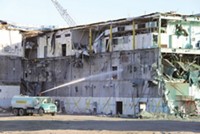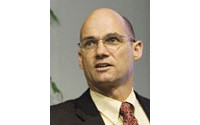Advertisement
Grab your lab coat. Let's get started
Welcome!
Welcome!
Create an account below to get 6 C&EN articles per month, receive newsletters and more - all free.
It seems this is your first time logging in online. Please enter the following information to continue.
As an ACS member you automatically get access to this site. All we need is few more details to create your reading experience.
Not you? Sign in with a different account.
Not you? Sign in with a different account.
ERROR 1
ERROR 1
ERROR 2
ERROR 2
ERROR 2
ERROR 2
ERROR 2
Password and Confirm password must match.
If you have an ACS member number, please enter it here so we can link this account to your membership. (optional)
ERROR 2
ACS values your privacy. By submitting your information, you are gaining access to C&EN and subscribing to our weekly newsletter. We use the information you provide to make your reading experience better, and we will never sell your data to third party members.
Environment
Wildfire Closes Los Alamos
Natural Disaster: Lab, city are shuttered as crews fight to contain blaze
by Jyllian Kemsley
July 4, 2011
| A version of this story appeared in
Volume 89, Issue 27
The orange glow of the Las Conchas wildfire (June 29 boundary shown on the map in red) is visible in the hills above the city of Los Alamos.
A wildfire burning in New Mexico led officials to evacuate the city of Los Alamos and shut down the adjacent Los Alamos National Laboratory (LANL) from June 27 through at least July 1.
As of C&EN press time on June 30, no city or lab structures had burned. Dubbed Las Conchas, the fire lined the city and lab on the west and south sides, and had burned more than 92,000 acres, according to the New Mexico Fire Information website.
The fire briefly crossed over onto lab property on June 27, but it burned only about an acre and was put out within an hour, LANL Director Charles McMillan said at a press conference.
The blaze started about 12 miles southwest of Los Alamos around 1 PM local time on June 26, probably from a spark from a power line, Los Alamos County Fire Chief Doug Tucker said.
And the fire grew ferociously, says Alan J. Hurd, a Los Alamos resident and director of LANL’s Lujan Neutron Scattering Center. “By 9 PM we could see fire from the town—we could see the flames,” Hurd says. He and his neighbors spent the evening packing to evacuate.
When the official evacuation order came on Monday, Hurd, his girlfriend, and two students staying with them for the summer took refuge with friends in El Rancho, a small town about 10 miles east of Los Alamos.
Sandia National Laboratories’ New Mexico site is located in Albuquerque, 60 miles to the southwest and out of range of the fire.
Los Alamos was devastated a decade ago by the Cerro Grande fire, which burned nearly 50,000 acres, including several hundred homes and 7,400 acres of LANL property. Cerro Grande led the lab to purchase new fire-fighting equipment as well as to thin trees and clear other vegetation, according to a LANL statement.
LANL facilities are typically made of concrete, and are “not going to burn to the ground,” LANL Director of Operations Carl Beard said at a press conference. But thousands of barrels of radioactive solid waste—including contaminated gloves, tools, and other materials—are less protected. Those barrels are relatively far from the fire in an area clear of vegetation, however, and fire-suppressing foam is available to shield the barrels if necessary, officials said.
LANL also has a network of air-monitoring stations in the region to track chemical and radiological emissions from the lab. Additionally, the Environmental Protection Agency deployed its ASPECT aircraft to measure emissions in the area. As of June 30, air-sampling analysis showed that “what is in the air is the same as we would see in a typical forest fire situation in New Mexico,” Sen. Tom Udall (D-N.M.) said at a press conference.
The effect of the closure on the lab’s research programs is unclear, Director McMillan said. Even if the lab sustains no fire damage to facilities, officials don’t know yet when the lab will reopen.
One of the experiments interrupted by the lab closure was a five-day, multi-institute experiment using LANL’s Weapons Neutron Research Facility to probe ways to mitigate damage to mercury targets used to produce neutrons for scattering experiments. “This particular campaign was intended to be a key step in defining a next-generation target,” says John Haines, director of neutron facilities development at Oak Ridge National Laboratory. The team hopes to return to LANL to complete the tests after the lab recopens.




Join the conversation
Contact the reporter
Submit a Letter to the Editor for publication
Engage with us on Twitter